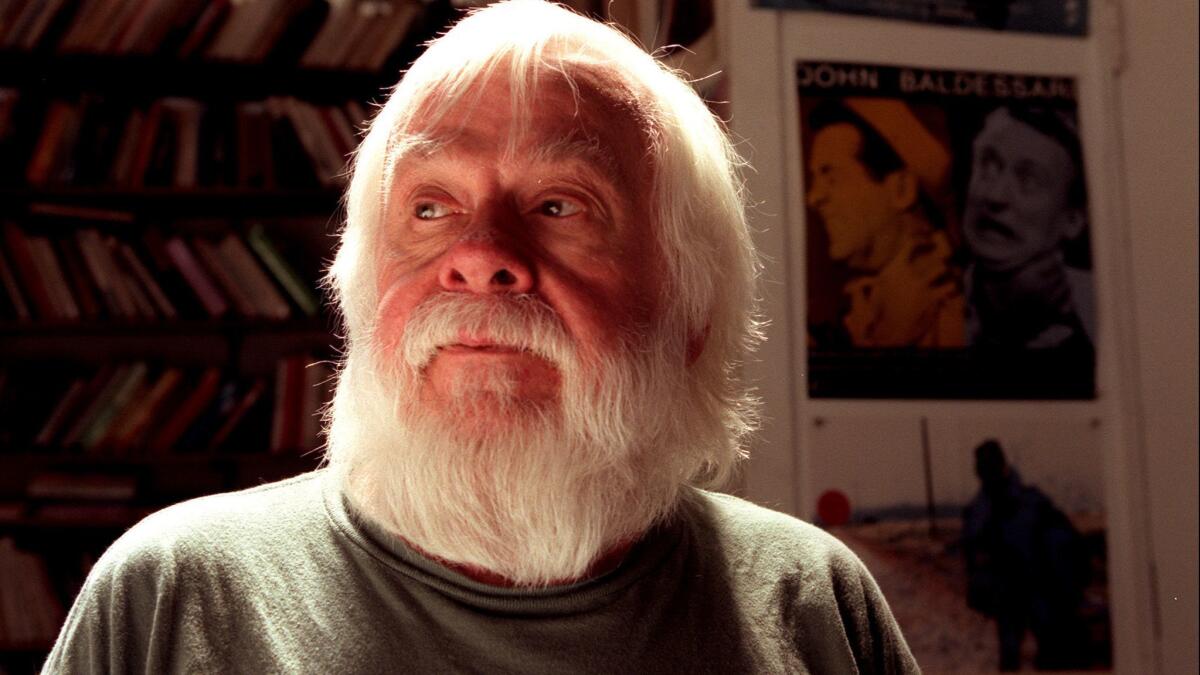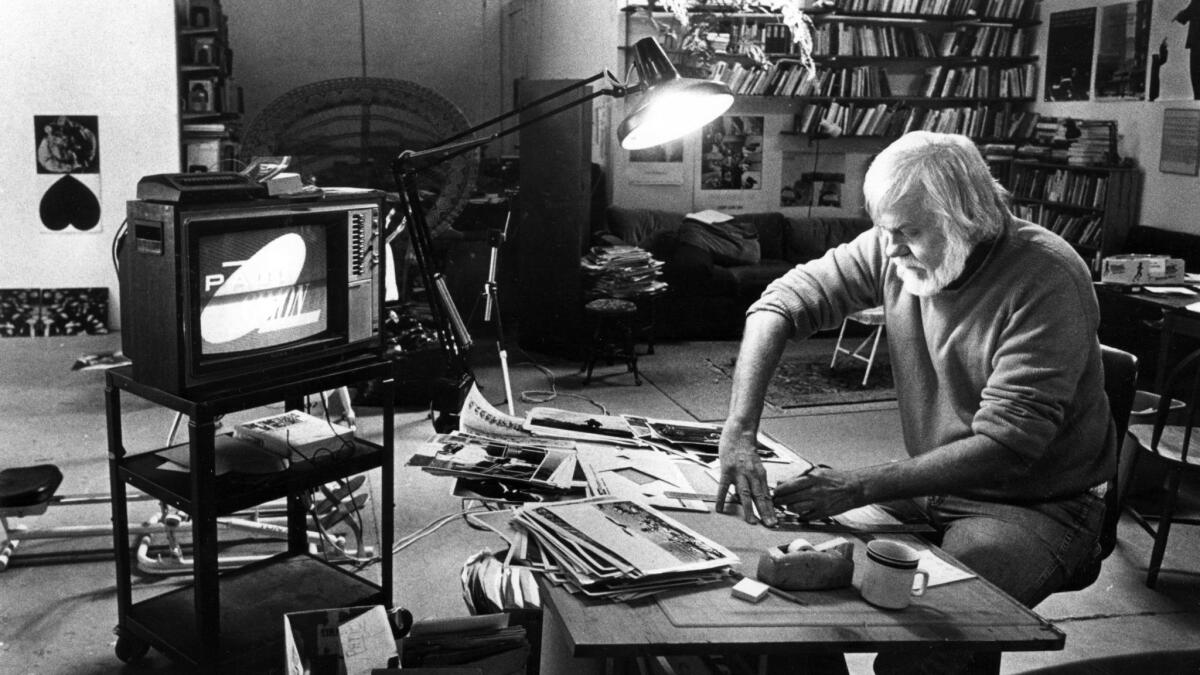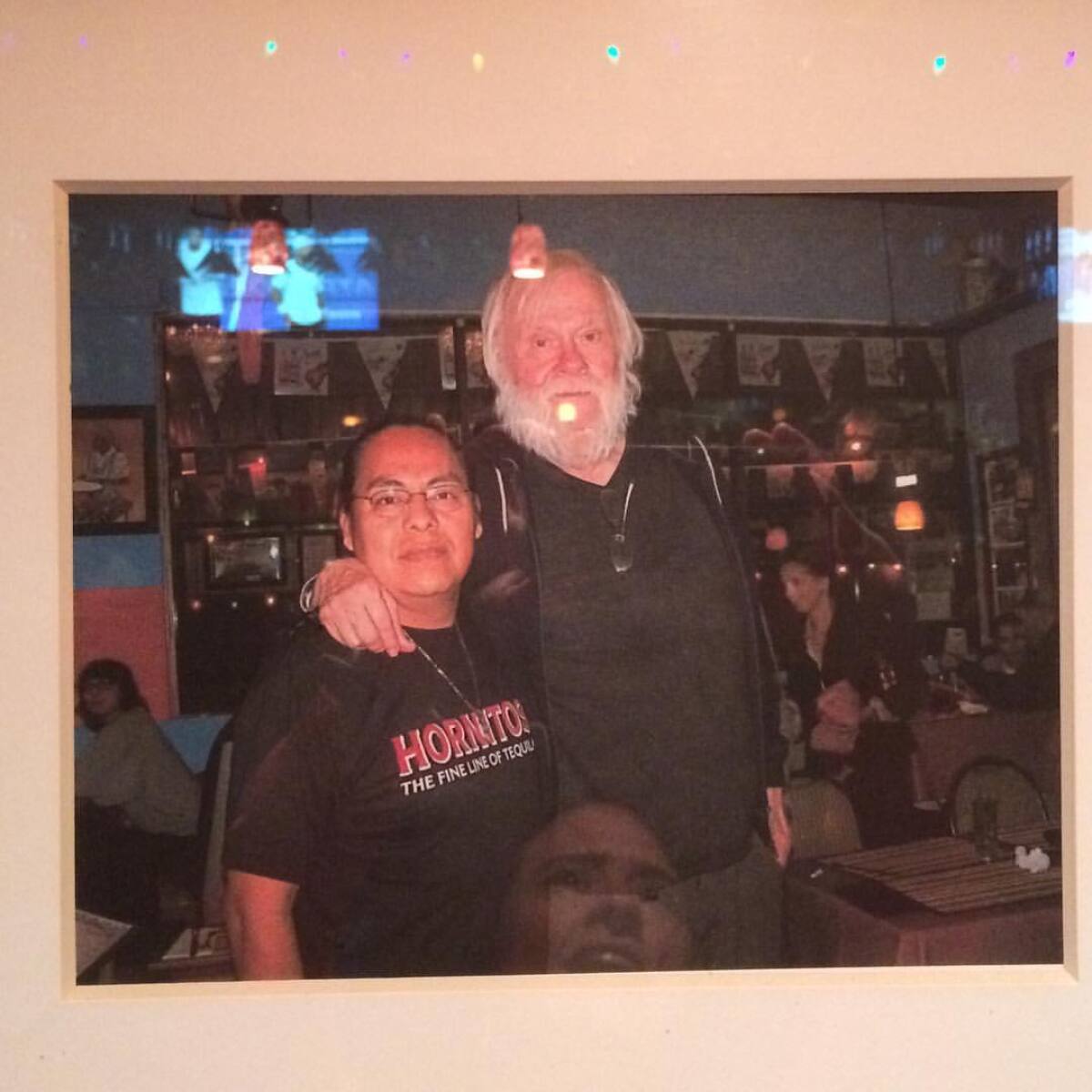Essential Arts: Remembering John Baldessari, artist of the absurd and profound

- Share via
Tributes to John Baldessari and threats to Iranian culture. The new year is kicking off with a lot of big headlines. I’m Carolina A. Miranda, staff writer at the Los Angeles Times, with your week’s dose of essential arts:
Giant of Conceptual art
He stood a towering 6 feet 7. But John Baldessari was a giant in other ways too: a key Conceptual artist known for works that read like absurd and cutting thought experiments, as well as an influential educator who taught artists such as Mike Kelley, Liz Craft, Jim Shaw and Rubén Ortiz Torres in his years at CalArts. Last week, Baldessari, who has been described as a “a gentle giant of Conceptual art,” died at the age of 88.
Suzanne Muchnic, Dorany Pineda and Deborah Vankin wrote The Times’ obit. “He poked at the art world,” art historian Lisa Wainwright told them. “He poked at institutions. He was unafraid and irreverent and playful ... and he was committed to teaching.”

We have a terrific excerpt of a conversation that contributor Barbara Isenberg had with Baldessari in the late 1990s. “Do I think Los Angeles has any influence on my work?” he told her. “I always answer that by saying that a shark is the last one to criticize saltwater. If you’re immersed in something, you can’t see it.”
In her years at The Times, my colleague Deb Vankin interviewed him on numerous occasions, including for a 2017 profile in advance of a show of new prints — some inspired by emoji — at Mixografia. “People look at what I do,” he told her. “I can’t ask for more than that.”
Plus, don’t miss this interview that Times art critic Christopher Knight did with Baldessari for Pacific Standard Time in 2012.
L.A. arts writer Jori Finkel, who wrote the artist’s obit for the New York Times, interviewed him for her book, “It Speaks To Me: Art That Inspires Artists,” in which he talked about why he was so intrigued by René Magritte’s famous 1929 painting, “The Treachery of Images (This Is Not a Pipe),” in LACMA’s collection. “It’s not a great painting,” he told her, “but it’s a great lesson in painting.”
I never had an opportunity to profile Baldessari. But I have dined in proximity of his visage: The artist was so well known in L.A. that he was on the fame wall (near John Leguizamo) at El Texate Mexican restaurant in Santa Monica.
RIP, good sir — see you in the afterlife over enchiladas de mole.

Make the most of L.A.
Get our guide to events and happenings in the SoCal arts scene. In your inbox every Monday and Friday morning.
You may occasionally receive promotional content from the Los Angeles Times.
Culture wars
After ordering the assassination of a top Iranian general, President Trump took to Twitter to threaten to strike cultural sites if Iran retaliated (a comment from which he later retreated). But the statement ignited a media storm since attacking cultural monuments could be considered a war crime. Thomas P. Campbell, director of the Fine Arts Museums of San Francisco, told New York Times art critic Jason Farago that “threatening cultural sites in Iran is to reduce Western values to those of ISIS fanatics.”
Los Angeles Times reporters Melissa Etehad and Sarah Parvini take a broader look at how culture can be held hostage by political whim — including a fascinating story about the ancient silver chalice that ended up functioning as a diplomatic tool between the U.S. and Iran, and helped pave the way to a nuclear deal in 2013.
Iranian architect Mohammad Hassan Forouzanfar has responded to the controversy with a conceptual project that imagines placing white flags over UNESCO and world heritage sites in Iran.
Classical notes
Composer Hildur Guðnadóttir became the first solo woman to win a Golden Globe for original score for her compositions for “Joker.” Guðnadóttir also composed the haunting score for HBO’s “Chernobyl,” which was made entirely with sounds recorded at a power plant in Lithuania.

And since we’re on the subject of scores: Contributor Tim Greiving reports on how director Terrence Malick has historically used music to support the impressionistic nature of his narratives. He speaks with composer James Newton Howard, who created the “elegiac” score for the director’s latest movie, “A Hidden Life,” about an Austrian farmer who refuses to pledge loyalty to Hitler. And Hans Zimmer, who scored Malick’s “The Thin Red Line,” shares insights into the director’s “elusive” working process.
Enjoying this newsletter? Consider subscribing to the Los Angeles Times
Your support helps us deliver the news that matters most. Become a subscriber.
In the galleries
In shows at the Orange County Museum of Art and the Huntington Library, as well as an installation at the most recent Chicago Architectural Biennial, L.A.-based artist Carolina Caycedo attempts to reframe the ways we view nature and history. Of her video at the Huntington, which features ghostly dancers moving through Henry Huntington’s splendid estate, she tells me: “What happens if the past rebels and comes back and says, ‘You’re not going to use me in the way you want and I’m going to inhabit it in the way that I want.’”
Everything dance
Dance Camera West, a festival featuring 55 films (mostly shorts) that center on dance, is going down through Saturday at REDCAT, with a Sunday event at Downtown Independent. The films, writes Times staff writer Michael Ordoña, are “imaginative, emotional and beautifully realized for the screen.”
Karla Peterson, at our sister paper, the San Diego Union-Tribune, reports on Flannery Gregg, the young San Diego choreographer who helped make the ebullient dance scenes in Greta Gerwig’s “Little Women” a reality. It’s San Diego connections all around because the film’s principal choreographer, Monica Bill Barnes, is a graduate of UCSD.
Plus, Sienna Lalau is the 19-year-old choreographer behind K-pop superstars BTS. This story sent me down a rabbit hole of dance videos.
Ready for the weekend
I round up all the artsy fartsies in my weekly Datebook, which includes Jacob Hashimoto’s kite-inspired prints and a show of mystic beings by painter Lezley Saar.
Matt Cooper, as is customary, has eight great things to do in L.A. and O.C. this week. He also has everything going down in theater, classical music, dance and art — such as the graceful Madonna painted by Raphael in the early 16th century that is going on view at the Norton Simon.
Get ready to party hearty at the MOCA on Saturday. Starting this weekend, the museum is doing away with its admission fees, making access to both downtown locations 100% free. To mark the event there will be food, music, performances and art-making workshops.
What I’m reading
The late painter Purvis Young told the stories of Miami’s black community in his work. When he died, the friend who had taken care of Young when he was alive, and to whom he had bequeathed almost 2,000 works, not only never saw the works, but never saw a cent. A staggering report by Deirdra Funcheon in the Washington Post Magazine.
In other news...
— Los Angeles Chamber Orchestra has a new executive director: Ben Cadwallader, from the Vermont Symphony Orchestra.
— Brush up on your Queens accents, Fran Drescher’s “The Nanny” is headed to Broadway as a musical.
— Plus, John Carney’s 2016 film “Sing Street,” about Dublin schoolboys who form a band, is also headed to the stage.
— Kris Yenbamroong of Night + Market, a chef who studied film and photography and once worked as an assistant to photographer Richard Kern, is the proprietor of a new art space in Venice called Le Maximum.
— Can the art world kick its addiction to flying? Kyle Chayka has a fascinating essay on the subject.
— Speaking of great reads, I love Alissa Walker’s dismembering of Elon Musk’s overhyped tunnels — er, I mean hyperloops.
— Anybody got a cool seven mil they can lend me to pick up John Lautner’s Wolff Residence?
And last but not least ...
Hyperallergic’s annual ranking of the 20 most powerless people in the art world. (Hint: the Marciano Art Foundation makes an appearance.)
The biggest entertainment stories
Get our big stories about Hollywood, film, television, music, arts, culture and more right in your inbox as soon as they publish.
You may occasionally receive promotional content from the Los Angeles Times.




